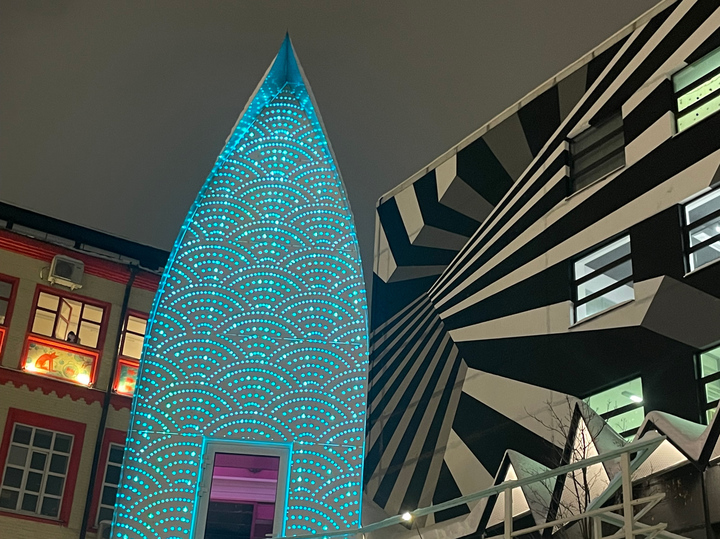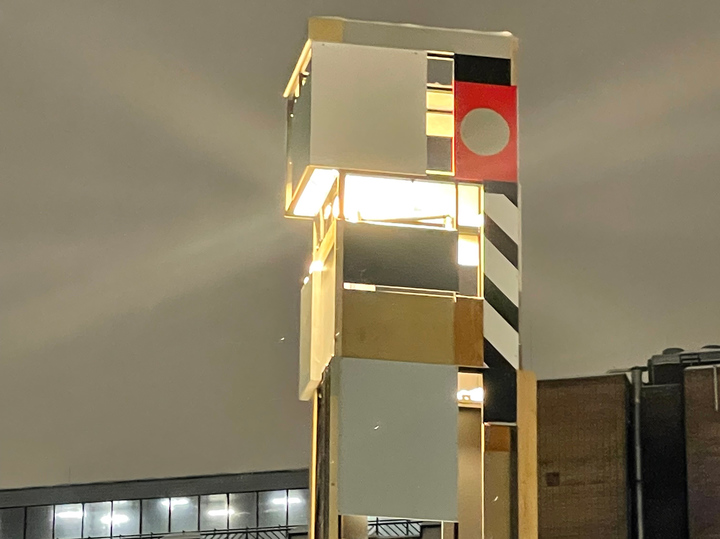“Electric Poetry” was lit at the Open Museum
[ad_1]
New art objects have become the “starting point” of an art territory with a 20-year history
“Reference Point” is the name of Alexey Luka’s installation, which appeared in the heart of the Artplay Design Center. The art object at the height of the third floor resembles a constructivist lighthouse, decorated with a red dot. Although in a symbolic sense, this is rather a comma between the 20-year history of the first creative space in Moscow, which was once an industrial zone, and a new stage in the life of an unusual museum, free for premises, which has no analogues.
Today, no one will be surprised by the fact that the territories of former factories and factories are being given over to creative clusters. There are many of them now, but Artplay was the first experiment and remains at the forefront, initiating the creation of projects in unusual formats. Over the course of 20 years, dozens of works of art appeared and disappeared on the territory. For the anniversary, the surviving works were put in order, restored, cataloged and systematized with the help of a map, which was also approached creatively (each object is marked with an icon with a schematic “Scream” by Munch). Now the Open Museum has 37 art objects of various sizes and formats. The territory is so rich that you can spend hours unraveling its secrets, wandering as if in a labyrinth and endlessly making discoveries.

There are large and spectacular things, comfortably hidden from view, and there are miniature ones. For example, the installation of steel braids called “Whisper” by Alexander Morozov, which appeared at the Open Museum last year, is grandiose. The blades are intertwined and twist into a whirlwind, and their outlines resemble the towers of Shukhov and Tatlin. At night, the art object is illuminated from the inside, turning into a beacon. Benches and tables are comfortably placed around the steel “hurricane” in the open air, and behind it every now and then another train rushes along the railway tracks. “Whisper” is a monument to nothingness. “Memento mori,” the author seems to say, recalling modernization and collectivization. And the entire art object is very meditative.

The counterbalance to this object is a cheerful multi-part mural dedicated to the local cat Vincent. The story of his life is told as a comic book by artists Ekaterina Dmitrieva and Mikhail Labazov on one of the buildings – the pictures seem to be inscribed in red window frames. That is, in the windows there is the real life of creative youth who are engaged in art in the art cluster, and below them the real fate of the local symbol is sketched.

Not far from the chronicle of Vincent there is a glass “Digital Greenhouse” designed by architect Mikhail Antonov. Edible plants grow inside, which local cafes use to prepare dishes, but the meaning of the object is not only utilitarian, but also meditative. You can sit inside, among the purple rays and greenery, and think about the eternal with a view of other installations.

And recently the museum launched a new series called “Electric Poetry.” These are light installations, the authors of which experiment with words in order to “feel for something unpronounceable in the street space,” explains curator Kato Borodina. “The goal of these projects is to build a dialogue between the viewer and the street, to think critically and philosophically accept what we cannot change,” she adds. The first “electric poem” by artist Misha Marker was placed at the entrance to the art territory. “Hide your thoughts deeper,” reads the red inscription, with the last word flickering on and off. The second luminous stanza awaits in the finale – after passing through the entire art territory. On one of the buildings there is a two-color phrase by Maxim Im, where two lines are encrypted: “Emptiness” and “So be it.” The next stage in the museum’s development will be the creation of sound projects, with the help of which all objects will form a “talking poem.”
“We thought that we would be able to realize this sound idea already in this anniversary year, but we didn’t have time,” says the head of the museum, Yasha Mokhnacheva-Yavorskaya. — These should be conceptual sound stories that will interact with the viewer, and not play like an annoying organ-grinder non-stop. But within a year, six new works appeared, and we managed to systematize all the objects and see what was missing. Moreover, they are located not only on the street, but also inside buildings, all are accessible freely. We have selected objects that we will try to preserve forever as a permanent museum exhibition. In addition, there will be temporary projects. Next year we are going to organize exhibitions of digital and performative art. Let’s dedicate it to intangible shares. That is, here street art and the concept of “street art” go beyond the boundaries of the usual – these are not only murals and open-air installations, but also projects of various interdisciplinary formats.
[ad_2]
Source link






